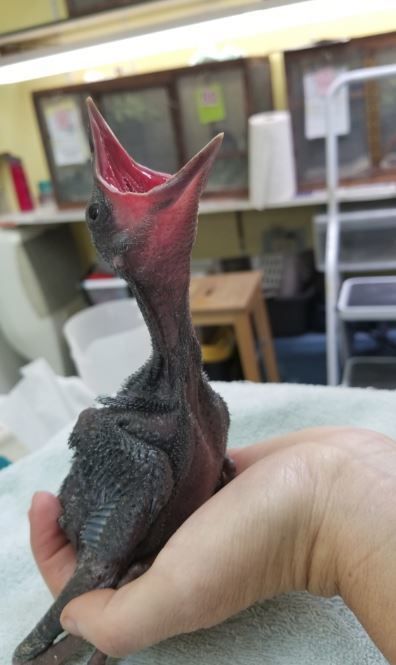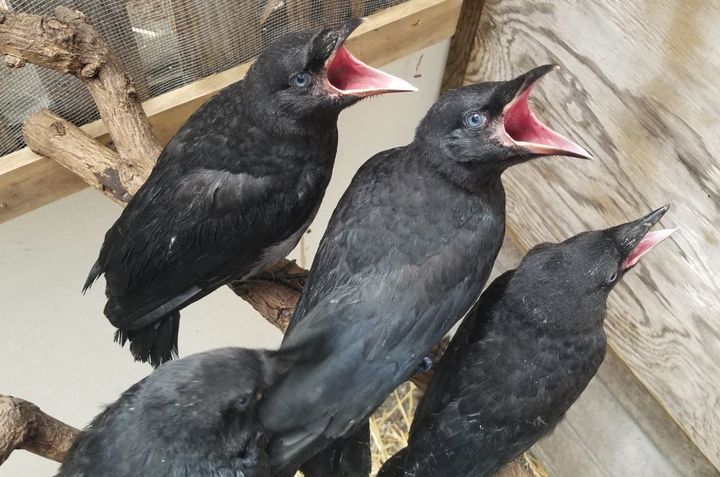WildCare's Wildlife Hospital treats nearly 4,000 ill, injured and orphaned wild animal patients from over 200 species every year. This is one group of patient's story.
How do you teach a baby crow to feed himself?
One of the most important jobs we have in WildCare’s Wildlife Hospital is to teach the orphaned wild babies that are in our care the skills they'll need to survive in the wild.
The first step in that process is to get them eating on their own. All of our orphaned patients, including our baby songbirds, need to be taught to recognize the food they'll be eating in the wild, and they need practice accessing it-- using their beaks, rocks and sticks to open food sources like nuts and even learning to cache food for later.
Baby birds start life with their parents bringing them food, so all baby songbirds are used to gaping their mouths upward when they're hungry. However, an adult bird finds his food on the ground, not arriving from above, so we need to teach the baby birds in our care to search for their own food at their feet.
Transitioning babies to finding food on their own takes some ingenuity on our part. Sometimes dropping the food in front of the baby's face makes him look down. Sometimes placing it on his foot will be annoying enough that he'll reach down and grab it, discovering in the process that it's edible.
Each feeding time features new ways to show these intelligent birds where their food can be found, and eventually, they figure it out and become self-feeding.

Very young baby crows look like pterodactyls! Photo by Melanie Piazza
Growing up crow
At WildCare right now we have over two dozen orphaned baby American Crows, and these curious, quizzical, uncoordinated babies are some of our most charming patients.
Baby crows go through an intensive graduation process as they mature. Each step is designed to keep these intelligent, high-strung birds comfortable and feeling safe, but also to stretch their boundaries to activate their natural curiosity. A "nudie" nestling baby crow does not yet have feathers or the ability to regulate his own body temperature, so he will start his care at WildCare in a tissue-lined nest placed inside a heated incubator.
Because we never raise baby wildlife alone, the nudie baby in the video below is paired with a blue-eyed baby crow (as they mature, crows' eyes will turn brown) that is a little bit older. These two will start their foster care in the incubator, and then they will be graduated to an enclosed carrier and then to a larger wire cage where they'll meet several new crow friends, also fellow orphans.
Crows are very gregarious and social, so raising groups of babies together gives them stimulation and a sense of security. These foster groups stay together for the entire duration of their stay at WildCare, and they will be released together too.
By necessity WildCare has multiple aviaries of various sizes to accommodate different species of birds, and we also use them for different age groups. From the wire cage these babies graduate to a small aviary, and then finally are moved into our largest aviaries to build up their flight muscles and endurance.

A group of baby crows begging at WildCare. As they mature and become self-feeding, these babies will become much more cautious around humans. Photo by Melanie Piazza
The introduction to each new environment is a mind-blowing experience for the baby crows. A straw-covered floor provides endless entertainment, and a box of raw earth may be scary at first, requiring a wary sideways approach, but eventually becomes great fun. Various levels of perches, with or without ramps, invite exploration and a sense of triumph when the highest point is reached.
Great care is taken throughout these babies' development to ensure that contact with humans is kept to a minimum. We work hard to train the young birds to scavenge on their own so they don't acquaint humans with food. These babies must show a crow's natural wariness of humans before they can be released. Click to learn more about crows and their co-development with humans.
The corvid babies in these videos will stay at WildCare for several weeks until they're grown up and independent enough for release back into the wild. Crow Baby Season at WildCare, however, will continue nonstop through the summer.
Story and video by Alison Hermance and Melanie Piazza
WildCare is a 501(c)3 nonprofit organization supported almost entirely by private donations and individual memberships. Visit us online at discoverwildcare.org.
